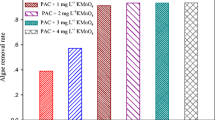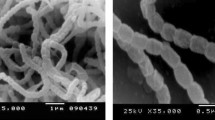Abstract
The presented work is devoted to the study of the ecological potential of Spirulina Arthrospira platensis to absorb copper ions from the water polluted by given heavy metal. The obtained data reveal the ability of Spirulina in a short time, in particular for 3 days to diminish 70% of Cu2+ ions of the initial incubation medium (100 ppm). The physiological parameters of Spirulina under the influence of copper on algae were also studied the highest concentration of Cu2+ ions cause inhibition of biomass accumulation by 15% and decrease of chlorophyll content by 30%. The presented results underline the capacity of Arthrospira platensis for the purification of water contaminations by copper.




Similar content being viewed by others
References
Al-Homaidan, A. A., Al-Houri, H. J., Al-Hazzani, A., et al. (2014). Biosorption of copper ions from aqueous solutions by Spirulina platensis biomass. Arabian Journal of Chemistry, 7, 57–62.
Arnon, D. I. (1949). Copper enzymes in isolated chloroplasts, Polyphenoloxidase in Beta vulgaris. Plant Physiology, 24(1), 1–15.
Brekke, L. D., Kiang, J. E., Olsen, J. R., et al. (2009). Climate change on water resources management: a federal perspective. Science for a changing world https://pubs.usgs.gov/circ/1331/Circ1331.pdf. Accessed Oct 2019.
Buadze, O., Sadunishvili, T., & Kvesitadze, G. (1998). The effect of 1,2-benzanthracene and 3,4-benzpyrene on the ultrastructure of maize cells. International Biodeterioration and Biodegradation, 41(2), 49–54.
Butterwick, C., Heaney, S. I., & Talling, J. F. (1982). A comparison of eight methods for estimating the biomass and growth of planktonic algae. British Phycological Journal, 17(1), 69–79.
Celekli, A., Yavuzatmaca, M., & Bozkurt, H. (2010). An eco-friendly process: predictive modelling of copper adsorption from aqueous solution on Spirulina platensis. Journal of Hazardous Materials, 173, 123–129.
Cepoi, L., Rudi, L., Chiriac, T., et al. (2016). Cyanobacteria for bioremediation of wastewaters. In L. Cepoi (Ed.), Biological methods of wastewater treatment (pp. 45–60). Berlin: Springer.
Cho, R. (2011) From wastewater to drinking water. Earth Institute Columbia University, https://blogs.ei.columbia.edu/2011/04/04/from-wastewater-to-drinking-water/. Accessed Oct 2019.
Ciferri, O. (1983). Spirulina, the edible microorganism. Microbiological Reviews, 47(4), 551–578.
Eid, U. (2015). The importance of water, sanitation and hygiene as keys to national development. US: Water magazine, https://www.issuelab.org/resource/importance-of-water-sanitation-and-hygiene-as-keys-to-national-development.html. Accessed Oct 2019.
Fang, L., Zhou, C., Cai, P., et al. (2011). Bonding characteristics of copper and cadmium by cyanobacterium Spirulina platensis. Journal of Hazardous Materials, 190, 810–815.
Frieman, E. A., Kates, R. W., Arizpe, et al. (1999). Our common journey. Washington, D.C.: National Academy Press https://www.nap.edu/read/9690/chapter/1. Accessed Oct 2019.
Hazrat, A., Khan, E., & Sajad, M. A. (2013). Phytoremediation of heavy metals—concepts and applications. Chemosphere, 91(7), 869–881.
Khan, M. A., & Ghouri, A. M. (2012). Environmental pollution: its effects on life and its remedies. Journal of Arts, Science & Commerce, 2(2), 276–285.
Khan, Z., Bhadouria, P., & Bisen, P. S. (2005). Nutritional and therapeutic potential of Spirulina. Current Pharmaceutical Biotechnology, 6(5), 373–379.
Kim, J. (2018). Making every drop count. Outcome report. High-level panel on water outcome document. https://sustainabledevelopment.un.org/content/documents/17825HLPW_Outcome.pdf. Accessed Oct 2019.
Kurashvili, M., Varazi, T., Khatisashvili, G., et al. (2018). Blue-green alga Spirulina as a tool against water pollution by 1,1′-(2,2,2-trichloroethane-1,1-diyl)bis(4-chlorobenzene) (DDT). Annals of Agrarian Science, 16(4), 405–409.
Marczenko, Z., & Balcerzak, M. (2000). Separation, preconcentration and spectrophotometry in inorganic analysis. In E. Kloczko (Ed.), Analytical spectroscopy library (pp. 177–188). Amsterdam: Elsevier.
Markou, G., Mitrogiannis, D., Celekli, A., et al. (2015). Biosorption of Cu2+ and Ni2+ by Arthrospira platensis with different biochemical compositions. Chemical Engineering Journal, 259, 806–813.
Palaniswamy, R., & Veluchamy, C. (2017). Biosorption of heavy metals by Spirulina platensis from electroplating industrial effluent. Environmental Science: An Indian Journal, 13(4), 139.
Potters, G. (2013). Marine pollution. The eBook company https://www.arma.org.au/wp-content/uploads/2017/03/marine-pollution.pdf. Accessed Oct 2019.
Qadri, H., & Faiq, M. A. (2019). Fresh water pollution dynamics and remediation. In H. Qadri & M. A. Faiq (Eds.), Springer (pp.15–26). Singapore: Springer.
Sekomo, C. B., Rousseau, D. P. L., Saleh, S. A. A. E., & Lens, P. N. L. (2012). Heavy metal removal in duckweed and algae ponds as a polishing step for textile wastewater treatment. Ecological Engineering, 44, 102–110.
UNESCO World Water Assessment Programme. (2009). Water in a changing world. United Nations world water development report 3. UNESDOC Digital Library. https://unesdoc.unesco.org/ark:/48223/pf0000181993. Accessed 16 May 2020.
Verma. R., & Suthar S. (2015). Lead and cadmium removal from water using duckweed - Lemna gibba L.: Impact of pH and initial metal load. Alexandria Engineering Journal,54(4), 1297–1304.
Acknowledgments
We would like to acknowledge warmly our colleagues for the support and assistance: Professor Dr. mult. Angelika Ploeger, Project Director – VW, Sustainable Agriculture and Food Systems (SAFS), Kassel University, Germany; Professor Dr. mult. Hartmunt Vogtamnn - Kassel University, Germany; Professor Vakhtang Lejava Rector of the Agricultural University of Georgia; Natia Samushia Vice Rector of the Agricultural University of Georgia; Marina Karchava Vice Rector of the Agricultural University of Georgia; Professor Dr. Teo Urushadze, Dean of Agricultural and Nature Science School at Agricultural University of Georgia, SAFS program director from Georgia; Professor Nato Kobakhidze, PhD School coordinator of the Agricultural University of Georgia; Nino Katcharava SAFS program coordinator.
Funding
This work was supported by co-financing (№ 04/47) of Shota Rustaveli National Science Foundation (SRNSF) and Volkswagen Foundation the Doctoral Program “Sustainable and Agricultural Food Systems” (SAFS).
Author information
Authors and Affiliations
Corresponding author
Additional information
Publisher’s Note
Springer Nature remains neutral with regard to jurisdictional claims in published maps and institutional affiliations.
Rights and permissions
About this article
Cite this article
Tabagari, I., Chokheli, L., Adamia, G. et al. The Effectiveness of Arthrospira platensis for the Purification of Copper-Contaminated Water. Water Air Soil Pollut 231, 470 (2020). https://doi.org/10.1007/s11270-020-04841-2
Received:
Accepted:
Published:
DOI: https://doi.org/10.1007/s11270-020-04841-2




